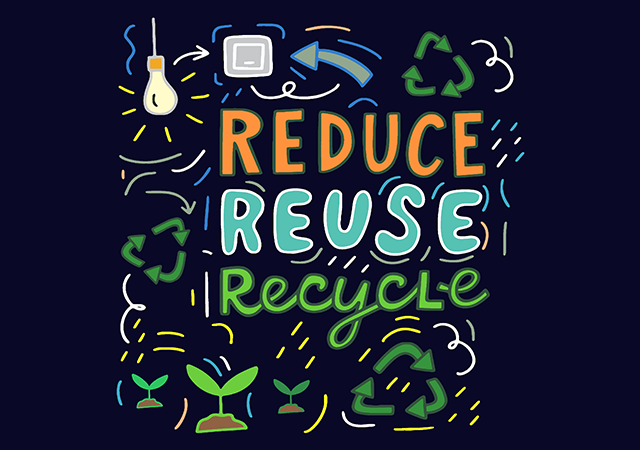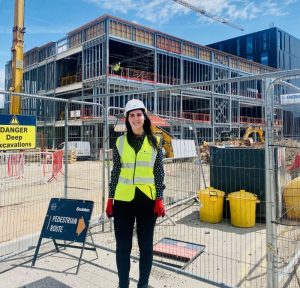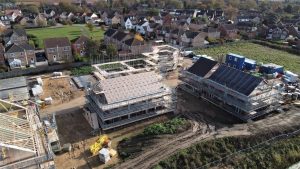In their 2020 edition of UK Statistics on Waste, DEFRA reports that construction, demolition and excavation activities generated around 62% of UK waste in 2016, of which 91% was recovered. While the industry’s recovery rate of non-hazardous construction and demolition waste sits comfortably above the 2020 EU target of 70%, we must not get complacent; despite coming a long way in recent years, the construction industry is still one of the largest contributors of waste in the UK.
With commentary from Laing O’Rourke and Galliford Try, in this blog, Faye Dolan, Framework Manager takes a look at some of the current best practice approaches to waste reduction and recycling and explores some of the innovative technologies which will help the industry improve performance.
Why Waste Costs…
In a cyclical process, the excessive and unnecessary waste generated from the construction process leads to the over production of construction materials and creates many issues for contractors and construction customers alike. Firstly, high levels of waste exacerbate the urgent problem of how we can reduce the carbon associated with construction activities; improved resource efficiency is an essential element of how we can meet our Net Zero Carbon commitments. As our built environment contributes almost 40% of all greenhouse gas emissions, 10% of which are directly associated with construction activities (such as manufacturing, transportation, construction, maintenance, and disposal), reducing waste is a priority.
Alongside the important environmental issues associated with waste, there is also the matter of cost. It goes without saying that high levels of waste on a project will negatively impact the profit margin and will also inflate costs for the customer. Insufficient design information; changes to the design; ineffective procurement and inefficient material handling can all lead to high levels of waste. Historically, a certain level of waste was factored in during the tender process, but, as we push to improve the sustainability of the construction process, this is no longer deemed as an acceptable solution.
Reduce, Reuse, Recycle
‘The 3 Rs’ is a common acronym throughout the industry and the philosophy promotes the idea that it makes more environmental and economic sense to reduce the materials we use in the first place. Most construction companies have now adopted the reduce, reuse, recycle waste hierarchy to encourage them to carefully consider the amount of materials they procure, to reuse materials when possible and to only finally recycle them if no further re-use is possible.
The EU’s Waste Framework Directive implemented in 2011, also encourages preventive measures as the best approach to tackling waste and the UK has made significant strides in improving performance. But despite this, there is still huge untapped potential for improving waste management in every part of the construction lifecycle.
Advanced technologies such as Building Information Modelling (BIM), smart manufacturing, lean construction techniques and innovative building materials, are now being leveraged by some industry leading contractors to enable them to design waste out of the process altogether and to enable the effective recycling of existing buildings and infrastructure…
1. ‘Circular Construction’ Approach
Taking the ‘reduce, reuse, recycle’ principal one step further, many design teams and construction companies are utilising a Circular Economy approach for their projects and their products. In a circular economy, products are engineered to be continuously reused or recycled to enable the value of products and materials to be maintained for as long as possible. When a product reaches the end of its life, it is used again to create further value, minimising waste and overall resource use.
Enabling resources to be ‘in use’ for as long as possible requires a rethinking of the design and manufacturing process. By considering at the design stage what will happen to the building at the end of its life, there lies huge opportunity to develop a product which can retain value and limit environmental damage. To facilitate the circular processes, the design and construction team need to jointly consider some important points, including:
• The lifetime of each separate element of a building project to optimise durability, resilience, and lifespan.
• Which components are ‘consumable’ and will need to be eventually recycled into new products (such as flooring) and which are ‘durable’ and can be reused (such as building services).
• The ease of which the finished product be deconstructed and disassembled (i.e, bolted rather than welded connections, screws rather than glue and nails)
• Opportunities for delivery and return logistics with material suppliers to support incentivised return options.
A Circular Construction approach can bring major economic and social benefits, such as innovative business opportunities and job creation, and can also help to protect businesses against material shortages.
Realising the value in ‘waste’ and the potential to increase the life span of waste materials is a key part of Laing O’Rourke’s strategy. Tom Higgins, Laing O’Rourke Director comments:
“We work closely with our partners to maximise re-use and recycling on all our projects. We challenge and support our supply chain to reduce waste and take back waste material for re-use and recycling, including take back of pallets, cable drums, off-cuts of various materials, and of re-usable packaging and protection. We also work with community partners to find uses for our waste materials; for example, many of our projects provide waste timber to members of the National Community Wood Recycling Project.”
2. Off Site Construction and Smart Manufacturing
Continuing in the same vain that reducing waste in the first place is a better, less carbon intensive alternative to recycling, off-site manufacturing has been proven to significantly reduce waste compared to traditional construction. The UK Government’s 2017 Transforming Infrastructure Performance report, encourages a faster uptake of off-site manufacturing to improve productivity, reduce waste and save money.
Components such as brackets, bolted frames and gantries are designed, produced and pre-assembled offsite in a quality-controlled environment, before being brought to site for installation. This process generates significantly less waste compared to traditional methods of construction (think excess offcuts, over-ordering, damage to stored materials and on-site packaging) and surplus materials can easily be reused and recycled in-house and diverted from landfill.
Whilst off-site manufacturing is not a particularly new concept, contractors are beginning to embrace this method of manufacturing in new and exciting ways to directly control their projects. Tom Higgins, Laing O’Rourke Director, continues:
“We have led the industry in adopting off-site construction techniques. Using digital design and precision manufacturing in our own factory, we have greatly reduced waste in the construction process. For example, in factory conditions we can reduce waste of reinforcement and concrete to as little as 0.5%, whilst our industry’s typical levels of waste of these materials on site is about 5%.”
Throughout the industry, one of the barriers to the uptake of off-site manufacturing is fragmentation across the supply chain. Fragmentation prevents the development of standard solutions and components which can be implemented across sectors. Proactive information sharing and supply chain collaboration are essential elements of a successful material efficiency strategy and so to address this issue, Galliford Try are working closely with their supply chain to bridge the gap and to implement efficiencies. Guy Cotton, Head of Work Winning at Galliford Try, comments:
“We work with our supply chain partners to reduce resource intensive processes and improve quality through a component focussed, manufacturing approach. Working together we avoid surplus materials and identify processes to remove packaging and eliminate waste creating activity. Where waste is created, we endeavour to reuse as much as possible, and maximise the use of secondary and recycled materials themselves. Technology allows our teams to assess the whole life of a project improving the ability to recycle buildings and infrastructure at the end of their useable lives. The focus on these areas has seen our teams reduce our waste per £100,000 from 16.4 tonnes per year to 14.5, and more than 95% of waste diverted from landfill.”
3. Using BIM to Design Out Waste
A significant benefit of BIM technology is the ability to reduce waste by creating a robust, accessible model with accurate quantities, and making it available to everyone in the team.
Design changes and interface clashes are an inherent part of the construction process, but BIM technology is helping contractors to avoid these issues. A visual representation of the finished product is developed before any of the physical construction works begin, reducing the margin for error and misunderstanding and detecting clashes early. Guy Cotton describes the importance of this technology to plan effectively and in turn reduce material consumption:
“We (Galliford Try) adopt a policy of ‘reduce, reuse and recycle’ to tackle the challenge of construction waste. The first step is to design out as much waste as possible, using technology such as BIM to standardise components and eliminate waste during manufacture. 4D BIM allows us to assess the construction methods and identify ways to incorporate temporary works into the permanent works, further reducing waste.”
The uptake and understanding of BIM are increasing all the time and, as the pressure mounts to achieve Net Zero Carbon, the technology is increasingly being hailed as the answer to the construction sector’s sustainability crisis.
4. Recycling and Retrofitting Old Buildings
When reviewing our approach to recycling and the future of the industry, it is important to consider the principal of recycling on a wider stage. Historic England in their 2020 Heritage Counts report are calling for older buildings to be refurbished and retrofitted with sustainability enhancing technology, rather than demolishing them and replacing with new builds. The report finds that compared to refurbishing a traditional Victorian terrace, a new building of the same size produces up to thirteen times more embodied carbon. This equates to around 16.4 tonnes of CO₂.
The CO₂ emissions already embodied within existing buildings are not lost through demolition, embodied carbon emissions in fact arise from three distinct stages of a building’s life cycle; when it is built, its daily functions and its demolition. There is growing evidence that ‘recycling’ and adapting old buildings will be a key part of how the UK can meet the 2050 carbon neutral targets and reduce the levels of waste produced by the industry.
5. Embracing Technology to Create New Materials from Waste
As part of the effort to cut the emissions generated from construction, researching and developing renewable materials with high recycled content to replace the traditional construction materials will be essential. The race is on to find alternative materials which require less energy, water, and non-renewable resources to produce, but which provide the same (or improved) performance.
There are various materials available already with high recycled content, such as panel board products, fibreboards (MDF), recycled aggregates and wood-plastic composites, but there are many new products in development and early use which offer the exciting potential of real environmental change.
• Plastic bricks are proving to provide a viable solution to the ever-increasing challenge in the disposal of plastic. Plastic is reused and mixed with cement aggregates to create shapes of bricks and provide a light weight, high insulating alternative to traditional bricks.
• ‘Green concrete’ manufactured from waste materials such as mining wastes, glass wastes, and burnt clay, looks promising to provide a low-maintenance and long-lasting renewable material for construction. Green concrete is said to have the potential to reduce the concrete industry’s CO2 emissions by 30% and increase the concrete industry’s use of waste products by 20%.
• Another waste stream that could be used to create sustainable materials is food waste and organic materials. We have recently seen the development of ‘mushroom bricks’ grown in a matter of days and the use of waste potatoes to make insulation and acoustic absorbers.
Growing consumer awareness and the challenging environmental targets we are faced with over the coming decades will put the construction sector under increasing pressure to move away from the conventional and towards the sustainable, on a much wider scale.

Faye Dolan, an esteemed professional and Framework Director at Procure Partnerships, boasts a rich and diverse career spanning seven years in the construction industry. Faye’s journey within Procure Partnerships began in 2018 as a Key Account Manager, initially overseeing the North West region and later extending her purview to the entire North.



